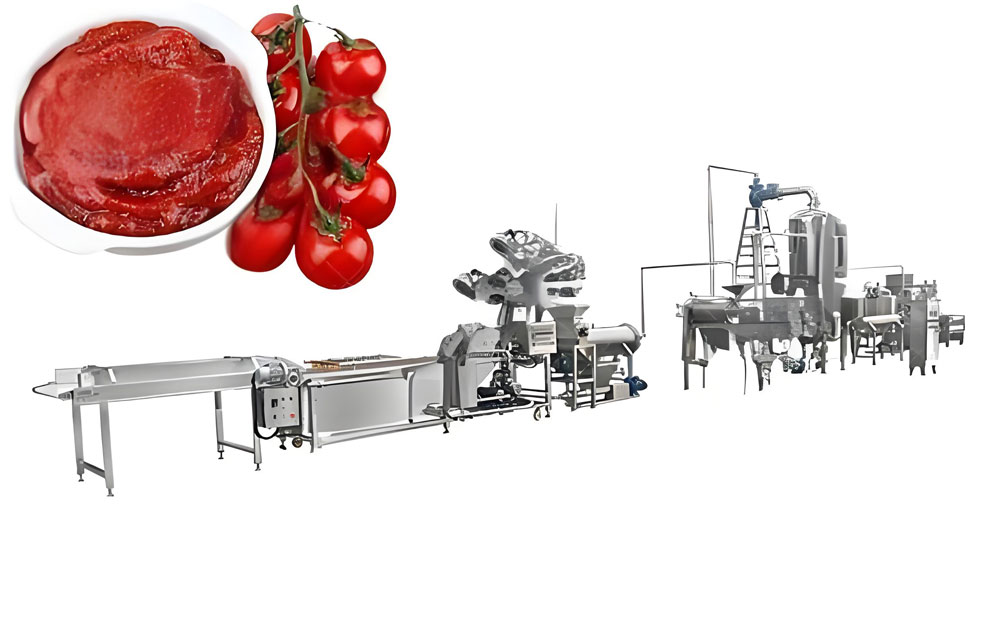What Equipment Is Requied For Tomato Sauce

Tomato sauce is a staple ingredient in kitchens worldwide, cherished for its versatility and rich flavor. Whether you’re running a commercial tomato sauce production line or making sauce at home on a larger scale, having the right equipment is crucial. This article will walk you through the essential equipment needed for tomato sauce production, provide insights into their functionalities, and help you streamline the production process efficiently.
Why Is the Right Equipment Important?
The tomato sauce production process involves multiple steps, including washing, peeling, grinding, cooking, and packaging. Using the appropriate equipment ensures:
- Efficiency: Speeds up the production process.
- Consistency: Maintains uniform quality and texture.
- Hygiene: Meets food safety standards.
- Cost-Effectiveness: Reduces labor costs and wastage.
Essential Equipment for Tomato Sauce Production
1. Tomato Washing Machine
Properly cleaned tomatoes are the foundation of a high-quality sauce. A tomato washing machine removes dirt, pesticides, and debris from the raw tomatoes.
- Key Features:
- High-pressure water spray or bubble washing.
- Stainless steel construction for durability and hygiene.
- Efficient drainage and filtering systems.
2. Tomato Sorting Conveyor
Sorting ensures that only the best tomatoes go into your sauce. A sorting conveyor is used to separate overripe, under-ripe, or damaged tomatoes.
- Benefits:
- Maintains product quality.
- Reduces waste by removing unsuitable tomatoes.
3. Tomato Peeling Machine
Peeling is a critical step in sauce production to ensure smooth texture. Common methods include:
- Steam Peeling: Uses high-pressure steam to loosen the skin.
- Knife Peeling: Mechanical blades remove the skin.
4. Tomato Crushing Machine
Crushing tomatoes into pulp is the next step. A tomato crusher efficiently breaks down the tomatoes into a fine pulp while separating seeds and skin.
- Key Features:
- Adjustable crushing settings.
- High-capacity output.
5. Tomato Paste Processing Machine
This equipment thickens the crushed tomato pulp to the desired consistency. It includes:
- Evaporators: Remove excess water.
- Vacuum Concentrators: Maintain the sauce’s natural color and nutrients.
6. Cooking Equipment
Cooking enhances flavor and preserves the sauce. Depending on the production scale, you can choose:
- Steam-Jacketed Kettles: Even heat distribution for large batches.
- Induction Cookers: Ideal for small to medium-scale production.
7. Homogenizer
For a smooth and uniform texture, a homogenizer mixes the sauce thoroughly and reduces particle size.
8. Sterilization Equipment
Sterilization ensures the sauce is free of harmful microorganisms and extends its shelf life. Common methods include:
- Pasteurization: Heat the sauce to a specific temperature for a short time.
- UHT Sterilization: Ultra-high temperature treatment for extended shelf life.
9. Filling and Packaging Machines
Packaging is the final step to ensure the sauce reaches consumers safely and attractively. Options include:
- Glass Jar Filling Machines: Popular for premium sauces.
- Pouch Filling Machines: Suitable for cost-effective packaging.
- Can Sealing Machines: For long-term storage.
10. Auxiliary Equipment
Additional equipment to support the production process includes:
- Boilers: Provide steam for peeling and cooking.
- Cooling Systems: Quickly cool the sauce before packaging.
- Weighing Scales: Ensure accurate portioning.
Factors to Consider When Choosing Equipment
1. Production Scale
- For small-scale production: Compact machines with lower capacity.
- For industrial-scale production: High-capacity, automated equipment.
2. Material and Build Quality
- Ensure the equipment is made from food-grade stainless steel to meet hygiene standards and resist corrosion.
3. Energy Efficiency
- Opt for machines that consume less energy while delivering high performance.
4. Maintenance Requirements
- Choose equipment that is easy to clean and maintain to reduce downtime.
5. Cost and ROI
- Compare the upfront cost with long-term benefits like efficiency and durability.
How to Maintain Tomato Sauce Production Equipment
1. Regular Cleaning
- Disassemble machines after each use and clean thoroughly to prevent contamination.
2. Lubrication
- Apply food-grade lubricants to moving parts to ensure smooth operation.
3. Inspection and Repairs
- Conduct routine inspections for wear and tear. Replace damaged parts promptly.
4. Training Staff
- Train operators on proper machine usage to prevent mishandling and accidents.
Top Brands for Tomato Sauce Production Equipment
Bertuzzi Food Processing
Specializes in turnkey tomato processing solutions.Fenco Food Machinery
Known for high-capacity, industrial-grade equipment.Tetra Pak
Offers advanced homogenization and sterilization technology.Yuanlin Food Equipment
Renowned for affordable and durable small-to-medium-scale machinery.
Conclusion: Streamlining Tomato Sauce Production
Whether you’re a small-scale producer or running a large commercial operation, investing in the right tomato sauce production equipment is essential. From washing machines to packaging units, each piece of equipment plays a vital role in ensuring efficiency, quality, and food safety.
By carefully selecting high-quality, energy-efficient, and easy-to-maintain machines, you can streamline your production process and create a sauce that stands out in the market.
Must-Read Blogs For Chain Restaurants Owner











 Aseptic Canning Production Line Equipment
Aseptic Canning Production Line Equipment Sweet Corn Canning Production Line
Sweet Corn Canning Production Line Egg Canning Production Line
Egg Canning Production Line Canned Fruit Production Line Equipment
Canned Fruit Production Line Equipment
Ready to Get Started?